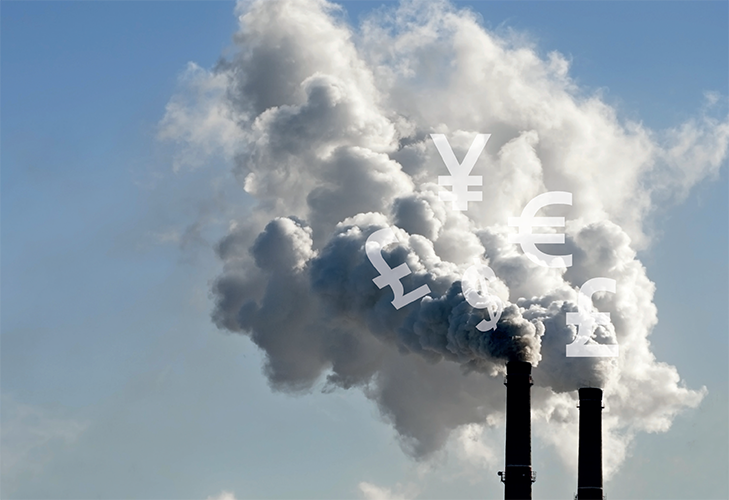
Plan ahead
Carbon pricing discussions continue apace on the global stage. Carbon pricing essentially involves putting a price on emissions so that low carbon choices are incentivized. A World Bank report has suggested that around 64 carbon pricing mechanisms are in play internationally, covering more than 20 per cent of global emissions and these numbers are expected to increase rapidly.
A major concern of businesses, especially those operating multi-nationally, is the cost of dealing with a patchwork quilt of differing carbon pricing instruments from country to country. A global carbon pricing mechanism applying across borders is reportedly being looked at. Such a worldwide system was considered during the negotiations leading to the 1997 Kyoto Protocol and in fact a conclusion on carbon pricing was ratified by 191 countries. This initiative largely fizzled out though not least as the US was not one of the ratifying countries.
Various bodies, including the International Monetary Fund (IMF), the World Bank and the Organisation for Economic Co-operation and Development have called for action in this area. The IMF proposed that an international carbon floor price be implemented, stressing that currently only one-fifth of carbon emissions are covered and that the globally average price is only USD3 per tonne.
In the US, support is growing for carbon pricing. Recently, former U.S. Energy Secretary Ernest Moniz was reported as saying “…yes, a carbon pricing mechanism, I think, would be the most straightforward way of doing two things. One, to shape the playing field – assuming the price, frankly, is high enough. But secondly, what carbon pricing would do is create a pool of resources that I would strongly urge be used in a progressive way” [CNBC, 6 September 2021]. The Biden administration is expected to be more inclined to consider carbon pricing than the previous US administration.
The Paris Agreement, adopted in 2015, provided outlines for three possible carbon pricing tools – bilateral agreements (whereby two countries could effectively share each other’s Nationally Determined Contributions – national emissions ceilings, effectively), a Sustainable Development Mechanism (an international market for carbon) and a co-operative, or non-market, voluntary approach whereby assistance would be given to matters such as climate policy development.
The biggest challenge would be meshing together differing national carbon pricing systems and bringing in countries which currently have no carbon pricing mechanism. Agreeing a harmonized carbon price would be very difficult not least due to the regional variations already in place – by September 2021, the price per metric ton of carbon in the UK emissions trading scheme (ETS) had risen to well over £50, and over EUR60 in the EU ETS, whilst the equivalent Chinese price was below USD10.
Following Brexit, the UK introduced a UK ETS, based largely on the existing EU ETS which had been in place for several years. Effectively, this is a cap and trade emissions scheme – emitters bid for emission allowances to set off against their emissions or to trade if they are unused, with the number of allowances reducing over successive auctions.
The UK has also been looking at whether to introduce a carbon border tax to impose financial penalties on imports from nations with no or less stringent carbon reduction measures. The UK has though held back from this for now largely to see how the EU’s proposals for a similar carbon border adjustment mechanism plays out.
In the UK, there is also the Carbon Price Support mechanism – in essence, a tax paid by fossil fuel power generators to supplement the UK ETS – and the Climate Change Levy (CCL) which is a levy on certain energy supplies to non-domestic consumers to encourage the use of low carbon fuels.
Carbon pricing featured in the Glasgow Climate Pact agreed as part of COP26 last November. Rules will be put in place to give substance to Article 6 of the Paris Agreement, with a view to creating an overall market for carbon emissions.
Whilst there was widespread disappointment at COP26 with India’s last-minute intervention to change language on ‘phasing out’ coal to ‘phasing down’ in the final pact, overall the event was important for the signals it sought to send to governments and markets around the world and carbon pricing now looms closer.
It is very unlikely that UK businesses will see a dramatic change in the carbon pricing regime immediately as a global system or any instruments which are agreed will take a reasonable period of time to roll out. The more likely change in the near to mid-term might be the introduction of carbon border adjustment mechanisms in the EU or elsewhere. Either way, as most UK businesses are already doing, planning ahead for reducing emissions makes financial as well as environmental sense.
 RICHARD COCKBURN
RICHARD COCKBURN
Richard Cockburn is a partner and head of energy at Womble Bond Dickinson. He is dual-qualified in Scotland and England & Wales. Richard has worked with developers and contractors in the renewable energy sector on projects ranging from onshore and offshore windfarms to renewable heat, solar, wave, tidal and other projects. His current work includes hydrogen and carbon capture, utilisation and storage projects across the UK.Ranking in the UK’s top 20 law firms, WBD provides comprehensive legal services to clients across a wide range of sectors, from seven cities across the UK, and 19 offices in the US. Since the earliest renewables projects over 25 years ago, the firm has advised key energy sector clients ranging from leading independents to major utilities and infrastructure funds.
For further information please visit: https://www.womblebonddickinson.com/uk